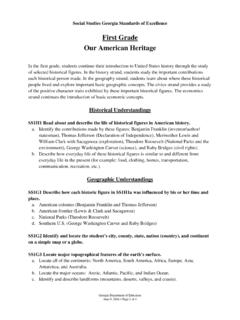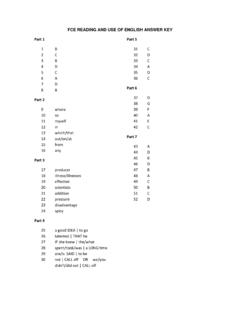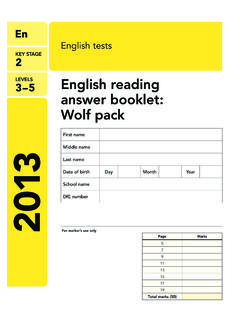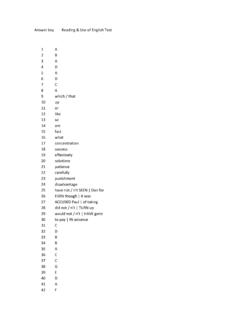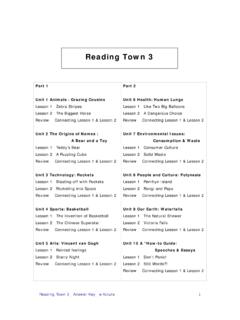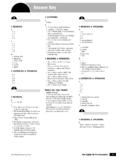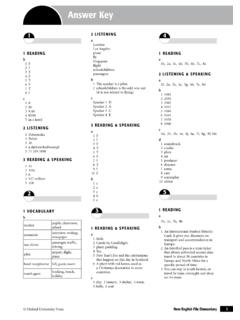Transcription of READING LITERARY (RL) READING …
1 3rd Grade english Language Arts georgia standards of Excellence (ELAGSE) georgia Department of Education April 15, 2015 Page 1 of 6 READING LITERARY (RL) READING INFORMATIONAL (RI) Key Ideas and Details Key Ideas and Details ELAGSE3RL1: Ask and answer questions to demonstrate understanding of a text, referring explicitly to the text as the basis for the answers. ELAGSE3RI1: Ask and answer questions to demonstrate understanding of a text, referring explicitly to the text as the basis for the answers. ELAGSE3RL2: Recount stories, including fables, folktales, and myths from diverse cultures; determine the central message, lesson, or moral and explain how it is conveyed through key details in the text.
2 ELAGSE3RI2: Determine the main idea of a text; recount the key details and explain how they support the main idea. ELAGSE3RL3: Describe characters in a story ( , their traits, motivations, or feelings) and explain how their actions contribute to the sequence of events. ELAGSE3RI3: Describe the relationship between a series of historical events, scientific ideas or concepts, or steps in technical procedures in a text, using language that pertains to time, sequence, and cause/effect. Craft and Structure Craft and Structure ELAGSE3RL4: Determine the meaning of words and phrases both literal and non-literal language as they are used in the text. ELAGSE3RI4: Determine the meaning of general academic and domain-specific words and phrases in a text relevant to a grade 3 topic or subject area.
3 ELAGSE3RL5: Refer to parts of stories, dramas, and poems when writing or speaking about a text, using terms such as chapter, sc ene, and stanza; describe how each successive part builds on earlier sections. ELAGSE3RI5: Use text features and search tools ( , key words, sidebars, hyperlinks) to locate information relevant to a given topic quickly and efficiently. ELAGSE3RL6: Distinguish their own point of view from that of the narrator or those of the characters. ELAGSE3RI6: Distinguish their own point of view from that of the author of a text. Integration of Knowledge and Ideas Integration of Knowledge and Ideas ELAGSE3RL7: Explain how specific aspects of a text s illustrations contribute to what is conveyed by the words in a story ( , create mood, emphasize aspects of a character or setting).
4 ELAGSE3RI7: Use information gained from illustrations ( , maps, photographs) and the words in a text to demonstrate understanding of the text ( , where, when, why, and how key events occur). ELAGSE3RL8: (Not applicable to literature) ELAGSE3RI8: Describe the logical connection between particular sentences and paragraphs in a text ( , comparison, cause/effect, first/second/third in a sequence). ELAGSE3RL9: Compare and contrast the themes, settings, and plots of stories written by the sa me author about the same or si milar characters ( , in books from a series). ELAGSE3RI9: Compare and contrast the most important points and key details presented in two texts on the same topic.
5 Range of READING and Level of Text Complexity Range of READING and Level of Text Complexity ELAGSE3RL10: By the end of the year, read and comprehend literature, including stories, dramas, and poetry, at the hi gh end of the gr ades 2-3 text complexity band independently and proficiently. ELAGSE3RI10: By the end of the year, read and comprehend informational texts, including history/social studies, science, and technical texts, at the high end of the grades 2-3 text complexity band independently and proficiently. 3rd Grade english Language Arts georgia standards of Excellence (ELAGSE) georgia Department of Education April 15, 2015 Page 2 of 6 Print Concepts Kindergarten and 1st grade only Phonological Awareness Kindergarten and 1st grade only Phonics and Word Recognition READING FOUNDATIONAL (RF) ELAGSE3RF3: Know and apply grade-level phonics and word analysis skills in decoding words.
6 A. Identify and know the meaning of the most common prefixes and suffixes. b. Decode words with common La tin suffi xes. c. Decode multi-syllable words. Fluency ELAGSE3RF4: Read with sufficient accuracy and fluency to support comprehension. a. Read on-level text with purpose and understanding. b. Read on-level prose and poetry orally with accuracy, appropriate rate, and expression on successive readings. c. Use context to confirm or self-correct word recognition and understanding, rereading as necessary. d. Read grade-appropriate irregularly spelled words. 3rd Grade english Language Arts georgia standards of Excellence (ELAGSE) georgia Department of Education April 15, 2015 Page 3 of 6 Text Types and Purposes WRITING (W) ELAGSE3W1: Write opinion pieces on topics or texts, supporti ng a point of view with reasons.
7 A. Introduce the topic or book they are writing about, state an opinion, and create an organizational structure that lists reasons. b. Provide reasons that support the opinion. c. Use linking words and phrases ( , because, therefore, since, for example) to connect opinion and reasons. d. Provide a concluding st atement or section. ELAGSE3W2: Write informative/explanatory texts to examine a topic and convey ideas and information clearly. a. Introduce a topic and group related information together; include illustrations when useful to aiding comprehension. b. Develop the topic with facts, definitions, and details. c. Use linki ng words and phrases ( , also, another, and, more, but) to connect ideas within categories of information.
8 D. Provide a concluding st atement or section. ELAGSE3W3: Write narratives to develop real or imagined experiences or events usi ng effective technique, descriptive details , and clear event sequences. a. Establish a situation and introduce a narrator and/or characters; organize an event sequence that unfolds naturally. b. Use dialogue and descriptions of actions, thoughts, and feelings to develop experiences and events or show the response of characters to situations. c. Use temporal words and phrases to signal event order. d. Provide a se nse of closure. Production and Dist ribution of Writing ELAGSE3W4: With guidance and support from adults, produce writing in which the development and organization are appropriate to task and purpose.
9 (Grade- specific expectations for writi ng types are defined in standards 1-3 above.) ELAGSE3W5: With guidance and support from peers and adults, develop and st rengthen writing as needed by pl anning, r evising, and editing. (Editing for conventions should demonstrate command of Language standards 1 3 up to and including gr ade 3.) ELAGSE3W6: With guidance and support from adults, use technology to produce and publish writing (using keyboarding sk ills) as well as to interact and collaborate with others. Research to Build and Present Knowledge ELAGSE3W7: Conduct short research projects that build knowledge about a topic. ELAGSE3W8: Recall information from experience or gather information from pr int and di gital sources; take brief notes on sources and sort evidence into provided categories.
10 ELAGSE3W9: (Begins in grade 4) Range of Writi ng ELAGSE3W10: Write routinely over extended time frames (time for research, r eflection, and revision) and shorter time frames (a single sitting or a day or two) for a range of discipline-specific tasks, purposes, and audiences. 3rd Grade english Language Arts georgia standards of Excellence (ELAGSE) georgia Department of Education April 15, 2015 Page 4 of 6 Comprehension and Collaboration SPEAKING AND LISTENING (SL) ELAGSE3SL1: Engage effectively in a range of collaborative discussions (one-on-one, in groups, and teacher-led) with diverse partners on grade 3 topics and texts, building on others ideas and expressing their own clearly.









